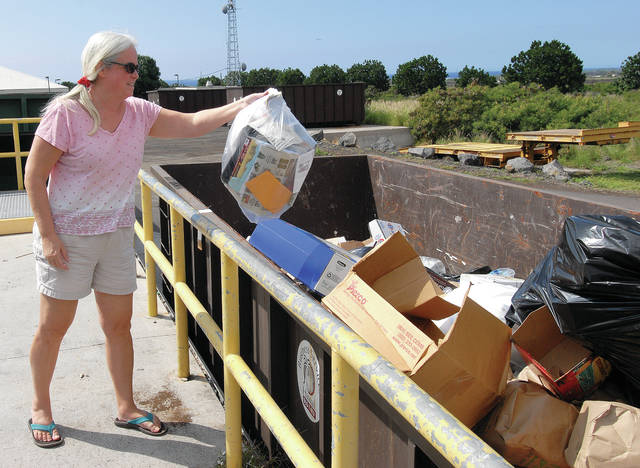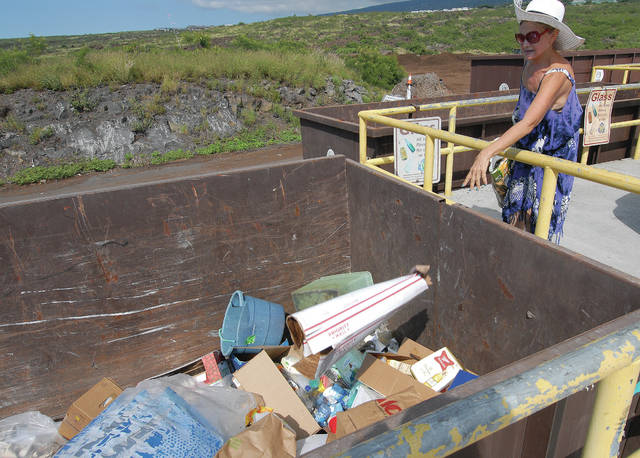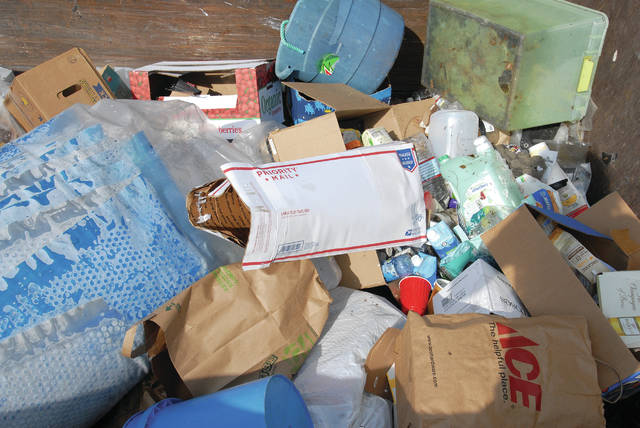China ups recycling regulations, causes ripple effect felt in Hawaii

Theresa Emerson tosses her recycle items in the mixed bin at the Kealakehe Transfer Station. (Laura Ruminski/West Hawaii Today)

Dvorah Henderson tosses her recycle items in the mixed bin at the Kealakehe Transfer Station. (Laura Ruminski/West Hawaii Today)

A variety of materials is found in the mixed recycle bin at the Kealakehe Transfer Station. (Laura Ruminski/West Hawaii Today)
KAILUA-KONA — China wants to rehabilitate its environment, but one of the country’s primary initiatives to do so could leave pollutants piling up over much of the rest of the world, including Hawaii.
KAILUA-KONA — China wants to rehabilitate its environment, but one of the country’s primary initiatives to do so could leave pollutants piling up over much of the rest of the world, including Hawaii.
The Chinese government announced earlier this year that beginning in January, it will raise its standards for contamination on recyclable materials to one-third of 1 percent — a mark experts have dubbed all but impossible to hit.
China amended that standard in mid-November to 1 percent contamination, according to Resource Recycling Inc., a multi-media publisher of industry business journals, but it remains onerously high.
A contaminant in this context is any substance present other than the target recyclable material — a piece of tape left on an envelope in a mixed paper bin, for instance.
“Essentially what China is saying is, ‘We don’t want your garbage,’” said Paul Buklarewicz, executive director of Recycle Hawaii, a nonprofit educational membership organization. “By cutting down on dirty loads, they think it’s going to help them clean up their environment.”
Recycling experts say China struggles mightily to regulate hundreds of paper mills and plastic plants, which don’t bother with landfills and illegally dump contaminated material or set flame to piles of plastic that rage more or less continuously.
So instead of focusing on the fruitless wrangling of non-compliant processing facilities within its own country, the Chinese have put the onus on companies that sell the country reclaimed materials.
Trickling economic effect
The economic impact of that decision is already being felt across the U.S., as sellers large and small scramble to secure buyers in other international markets, resulting in plummeting price points.
“The way China shut it down, it plays with the market,” said Dominic Henriques, owner of RRR Recycling, which holds the curbside recycling contract in Honolulu. “China doesn’t accept mixed paper and now the other countries that did are getting flooded with that, so there’s not the demand.”
Overhead is also increasing as companies like RRR hire more workers to meet higher contamination standards. Product also moves more slowly, as it must be inspected more meticulously.
If companies can’t secure new markets quickly enough, or if alternative buyers like Vietnam and India become inundated with material and stop buying for weeks or months, storage becomes a necessity.
Buying freezes would apply even greater strain to companies of all sizes, as it doesn’t make business sense to store too much for too long.
Henriques said RRR has enough space for short periods of moderate storage, but a six-month freeze would require renting a warehouse. Such extra costs aren’t sustainable long-term for many industry business models across the country.
“Everybody is in a tizzy because they won’t know until January how effective and extensive this is,” Jerry Powell, executive editor at Resource Recycling Inc., said in early November. “The prices for everything fell steeply and now have come back up a little this month.”
He added it’s devastating economically for operations in states like California and Oregon, which gather massive amounts of recycled material and deal heavily with China. It won’t hurt Hawaii as much, but businesses in the state aren’t likely to duck the developments unscathed.
Possible change to policy again
Powell said he expects the Chinese will eventually amend their 1 percent figure to 4 or 5 percent, a mark to which the industry could probably adjust.
“Most of the people I’ve talked to say they think China will back down and will probably start accepting bales of materials, from Hawaiian programs for instance, that are about 95 percent clean,” he explained. “You can’t get everything out, everybody knows that, but if you can get about 5 percent contamination, that’s going to be acceptable in my view.”
But the environmental consequences could be as widespread as the economic impacts if China holds to its position for a protracted period of time.
In Hawaii, that would be of particular concern as virtually no recycling happens in the state other than re-use applications. The minimal population can’t economically support the construction of processing facilities, meaning Hawaii has one of two choices — ship it or bury it.
“Worst-case scenario is they start landfilling all the stuff and not recycling at all if it’s too expensive to collect and ship,” Powell said.
Where to turn, and for how long
Recycling outfits in the United States have traditionally sent more than 40 percent of the country’s recovered paper and roughly one-third of its recovered plastics to mills in China. Most of Europe and other Asian countries also rely heavily on China to create a market for their recyclables.
“What will be affected is mixed plastics, mixed bottles and that sort of thing,” Powell said. “The other one it will affect is mixed paper. So it hurts the curbside and dropoff programs in America.”
As a bottle-bill state, a significant portion of what Hawaii ships may still make the grade.
That’s important, said Terry Telfer, president of Oahu-based Reynolds Recycling, as the bulk of recycled material in Hawaii goes to China — especially plastic.
Hawaii collects plastic directly through the consumer, he explained, meaning if recyclers want to get paid, they need to bring in a clean product.
Even still, both Reynolds Recycling and RRR Recycling have already secured new buyers to hedge against China refusing other loads out of Hawaii and rendering the economic model of shipping to the country unfeasible. If materials don’t make the grade and are sent back, the company that shipped them foots the bill.
RRR made the switch only two weeks ago, segmenting its various products and shipping them to Indonesia, Vietnam, South Korea and the Philippines. The company had previously sent all its cardboard, newspaper and polyethylene terephthalate to China, as well as other products.
Reynolds Recycling is now sending all of its plastics to Jakarta.
“It was a little bit of a scare, but our brokers quickly found alternative homes, and China should start to open up again. They always overreact,” Telfer said. “As time progresses, we fully expect the Chinese market to re-open to us.”
Powell explained that China’s newly enacted regulations create the potential for market expansion in the United States, which shut down some processing facilities as China formerly undercut purchasing prices.
But such expansion would require substantial investment, and Powell said it would take years to build the infrastructure on a large enough scale to absorb the supply overflow. Thus, optimism like Telfer’s has the industry standing still in the U.S.
“I don’t think anybody is making huge moves yet because they’re waiting to see what happens with China,” Henriques said. “I don’t think anybody wants to invest a lot of money and then see China come back strong again.”
Both Telfer and Henriques say there’s reason to keep a watchful eye on the situation but added they, and the rest of Hawaii, remain committed to recycling.
“I hope not,” Telfer responded when asked if Hawaii’s landfills will start gobbling up more recyclables. “The highest and best use of the materials is to get them recycled. It creates more jobs. If these boats didn’t have something to load up on the way back, they’d go back completely empty. So it keeps the freight costs down overall for everyone. I think the recycling industry is, in fact, the state’s largest exporter.”
Henriques answered similarly when asked if he was concerned that he won’t be able to move product like before.
“I would say yes,” he explained. “But I don’t think it’s going to be forever.”


